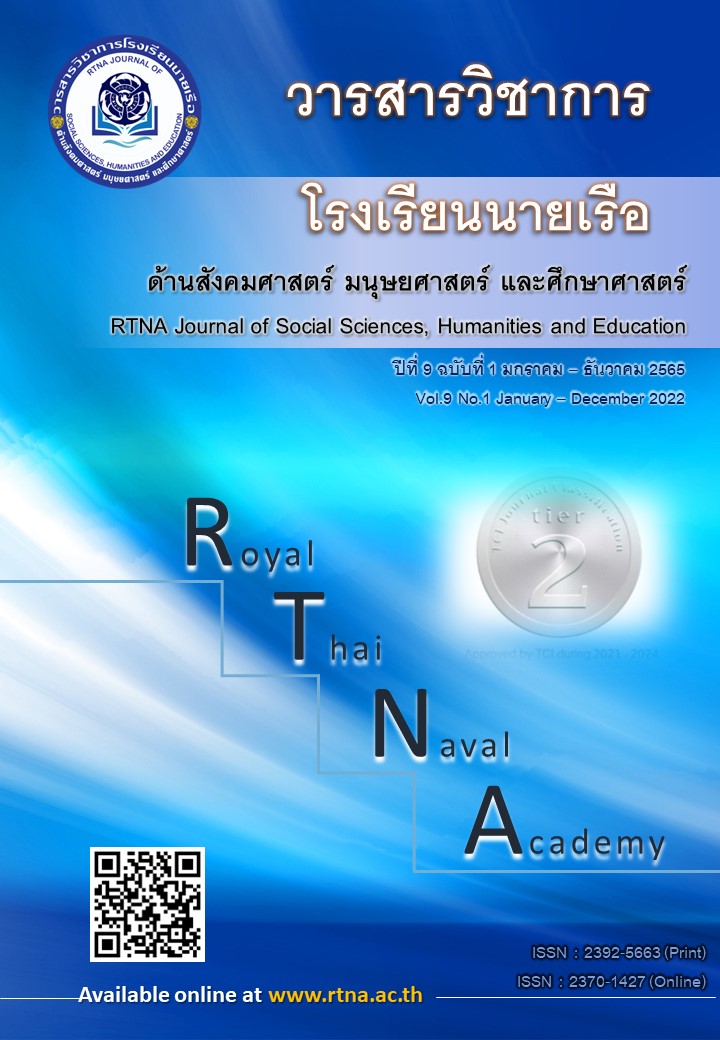Development of resilience scale concerned with social desirability responses for the Naval operational medicine school
Keywords:
Resilience, Social desirability, Naval operation medicine schoolAbstract
This research regarding development methodologies aims to develop resilience scale regarding social desirability responses of the Naval operational medical school (NOMS).
The samples consist of 110 NOMS students. The instruments are resilience scale and social desirability scale analyzed by descriptive statistic and inferential statistic. The results are as following. 1) The 26 items of resilience scale are 1.1) the discrimination index is between 0.20 - 0.73.,
1.2) the Index of Item–objective congruence (IOC) is between 0.60 to 1.00, 1.3) the second order confirmatory factor analysis shows that the measurement model has a goodness of fit =238.03 df=32 p=0.06 CFI=0.95 NFI=0.95 RMR=0.04 RMSEA=0.02) and 1.4) the Cronbach’s alpha coefficient is 0.89. 2) The results for 40 items of Social desirability scale are 2.1) the discrimination index is between 0.31-0.57, 2.2) the Index of Item-objective congruence (IOC) is between 0.60 to 1.00, 2.3) the second order confirmatory factor analysis shows that the measurement model has a goodness of fit
=1629.361 df=665 p=0.05 CFI= 0.98 NFI=0.95 RMR = 0.02 RMSEA=0.01) and 2.4) The Cronbach’s alpha coefficient is 0.90. 3). It can conclude that the most of NOMS students are at high resilience level and the rest are at medium level.
References
ขวัญธิดา พิมพการ. (2561). การพัฒนารูปแบบการให้คำปรึกษารายบุคคลแบบบูรณาการเพื่อเสริมสร้างความเข้มแข็งทางใจ ของสตรีที่มีการสูญเสียสามีในสถานการ์ความไม่สงบจังหวัดชายแดนภาคใต้ [ปริญญาดุษฎีบัณฑิต]. กรุงเทพฯ: มหาวิทยาลัยศรีนครินทรวิโรฒ.
จันทร์สุดา จันทร์นพคุณ. (2554). ระดับพลังสุขภาพจิตของพยาบาลจบใหม่หมุนเวียนที่ปฏิบัติงานในโรงพยาบาลจุฬาลงกรณ์ [วิทยานิพนธ์ปริญญามหาบัณฑิต, จุฬาลงกรณ์มหาวิทยาลัย]. Chulalongkorn University Intellectual Repository (CUIR). Retrieved from http://cuir.car.chula.ac.th/handle/123456789/46232
ณัฎฐภรณ์ หลาวทอง. (2561). การสร้างเครื่องมือการวิจัยทางการศึกษา. กรุงเทพ: สำนักพิมพ์แห่งจุฬาลงกรณ์มหาวิทยาลัย.
นุชปิยา ทองโชติ. (2564). การพัฒนาแบบวัดความสามารถในการฟื้นพลังที่คำนึงถึงการตอบตามความปรารถนาของสังคมสำหรับนักเรียนพยาบาลทหาร [วิทยานิพนธ์ปริญญามหาบัณฑิต]. กรุงเทพฯ: จุฬาลงกรณ์มหาวิทยาลัย.
ลัดดา แสนสีหา. (2562). การวิเคราะห์องค์ประกอบเชิงยืนยันความแข็งแกร่งในชีวิตของนิสิตพยาบาล มหาวิทยาลัยมหาสารคาม. วารสารสุขภาพจิตแห่งประเทศไทย, 27(3), 211-223.
ศิริชัย กาญจนวาสี. (2556). ทฤษฎีการทดสอบแบบดั้งเดิม (พิมพ์ครั้งที่ 7). กรุงเทพฯ: สำนักพิมพ์แห่งจุฬาลงกรณ์มหาวิทยาลัย.
สายสมร เฉลยกิตติ. (2563). แนวปฏิบัติที่ดีโครงการหยกปัญญา การพัฒนาศักยภาพนักเรียนพยาบาลในการสอบขึ้นทะเบียนและรับใบอนุญาตเป็นผู้ประกอบวิชาชีพการพยาบาล. สืบค้นจาก https://rtanc.ac.th/wp-content/uploads/2020/โครงการหยกปัญญา
สุกัญญา จันทวาลย์. (2556). การพัฒนาแบบวัดการตอบตามปรารถนาของสังคมนิสิตนักศึกษาไทย [วิทยานิพนธ์ปริญญาดุษฎีบัณฑิต, จุฬาลงกรณ์มหาวิทยาลัย]. Chulalongkorn University Intellectual Repository (CUIR). Retrieved from http://cuir.car.chula.ac.th/handle/123456789/43653
Bartone, P. T. (1989). The Impact of a military air disaster on The health of assistance workers. Nervous and mental disease, 177(6), 317.
Ebel, R. L. (1972). Why is a longer test usually a more reliable test?. Educational and Psychological Measurement, 32(1), 249-253.
Edens, J. F., Buffington, J. K., Tomicic, T. L., & Riley, B. D. (2001). Effects of positive impression management on the psychopathic personality inventory. Law and Human behavior, 25(2), 235-256.
Hair, J. F., Black, W., Babin, B. J., & Anderson, R. E. (2010). Multivariate Data Analysis: A Global Perspective (7th ed.). Retrieved from https://www.researchgate.net/publication/237009923_Multivariate_Data_Analysis_A_Global_Perspective
He, F. X., Turnbull, B., Kirshbaum, M. N., Phillips, B., & Klainin-Yobas, P. (2018). Assessing stress, protective factors and psychological well-being among undergraduate nursing students. Nurse Educ Today, 68, 4-12. doi:10.1016/j.nedt.2018.05.013
Kamtsios, S., & Batone, P. (2021). Preliminitary evaluation of the psychometric properties of The "Hardiness-Resilience Gauge" in an uedergrauate sample. Hellenic Journal of Psychology, 18, 287-310.
Nindl, B. C., Billing, D. C., Drain, J. R., Beckner, M. E., Greeves, J., Groeller, H., … Friedl, K. E. (2018). Perspectives on resilience for military readiness and preparedness: Report of an international military physiology roundtable. J Sci Med Sport, 21(11), 1116-1124. doi:10.1016/j.jsams.2018.05.005
Paulhus, D. L. (1991). Measurement and Control of Response Bias. In J. P. Robinson, P. Shaver, & Wrightsman (Eds.), Measure of Personality and social psychological attitudes. Retrieved from https://www.researchgate.net/profile/Delroy-Paulhus/publication/246790479_Measurement_and_Control_of_Response_Bias/links/59ddd2a5458515f6ef0670bb/Measurement-and-Control-of-Response-Bias.pdf
Van der Meulen, E., Van der Velden, P. G., Van Aert, R. C. M., & Van Veldhoven, M. (2020). Longitudinal associations of psychological resilience with mental health and functioning among military personnel: A meta-analysis of prospective studies. Soc Sci Med, 255(1), 112814. doi:10.1016/j.socscimed.2020.112814
Downloads
Published
Issue
Section
License
Copyright (c) 2022 Royal Thai Naval Academy

This work is licensed under a Creative Commons Attribution-NonCommercial-NoDerivatives 4.0 International License.
The author has the sole responsibility for the material published in RTNA Journal of Social Sciences, Humanities, and Education, which the editorial team may not agree on that material.
RTNA Journal of Social Sciences, Humanities, and Education owns the copyright of the text, the illustration, or other material published in the journal. No parts or the whole of the material published may be disseminated or used in any form without first obtaining written permission from the academy.






